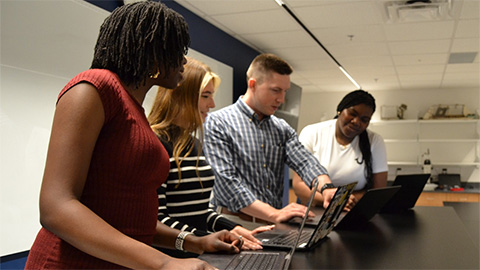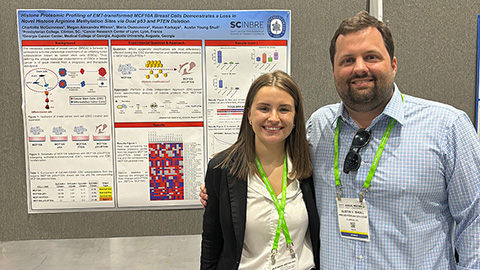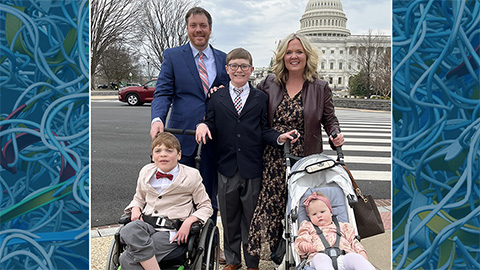This week’s staff picks
At the American Society for Biochemistry and Molecular Biology, we love to read as much as we love to write. We also love to talk about what we’re reading or watching or listening to. Our office is always buzzing (either with not-so-hushed voices or the ping of email deliveries) as we share the inspiring, emotionally compelling, fascinating or simply funny articles, podcasts or videos we can’t stop reading/watching/listening to/scrolling through. So, we figured, why not keep the conversation going?
Here’s a compilation of our staff’s favorites for the week. Enjoy, and feel free to tweet us (@ASBMB) your thoughts.
Vida Americana (Whitney Museum of American Art)
This exhibit, subtitled “Mexican Muralists Remake American Art, 1925 – 1945,” takes you back to the end of the Mexican Revolution in 1920. Their society was bursting at the seams, and these muralists were in the middle of it all. If you are familiar with Clemente Orozco, Diego Rivera and David Alfaro Siqueiros, you have an idea of what their work is like, but when you see these incredible large-scale murals, it’s downright overwhelming. Really. Watch the video, and you may be inspired to catch a train to New York see this show for yourself. I know I want to!
— Lisa Schnabel, senior designer
Great Big Story (YouTube)
I always resort to this YouTube channel after spending 30 minutes trying to find something to watch on my various streaming services. Their videos give you a glimpse into different cultures and lifestyles around the world through captivating storytelling. One of my favorite stories is about how a professor became a chalk dealer at his institution. I enjoy being able to learn something new every time I watch one of their videos.
— Stephanie Paxson, diversity and undergraduate education coordinator
COVID-19 highlights urgent need for increased public health funding (Association of State and Territorial Health Officials)
This Public Health Review podcast is an insightful conversation on the importance of funding the entire public health spectrum — from the perspective of public health experts who are and will be on the front line of this public health emergency.
— Benjamin Corb, public affairs director
February Evening in New York (Denise Levertov/Poetry Foundation)
I subscribe to Poetry magazine from the Poetry Foundation. It’s a highlight of my month when it arrives. I keep the issues on my coffee table, along with a rotation of some of my favorite poetry books. Whenever I feel confused or worried about some life circumstance (which I admit is weekly, if not daily … or hourly), I flip through a poetry book and usually land on something that I relate to — that helps knock some of the loneliness out of the worry. I also subscribe to the Poetry Foundation’s “Poem of the Day” email. Below is part of the poem for Feb. 26, by Denise Levertov. I really liked it, I hope you do too.
As the buildings close, released autonomous
feet pattern the streets
in hurry and stroll; balloon heads
drift and dive above them; the bodies
aren't really there.
— Ally Frick, multimedia and social media content manager
Industrial pollution is in your blood. Is that a form of battery? (Sara Talpos, Undark)
For decades, multinational companies just couldn’t quit per- and polyfluoroalkyl substances, or PFASs. Developed in the 1950s, the chemicals were used in the manufacturing of nonstick cookware, water-repellent clothing, stain-resistant fabrics and carpets, cosmetics, firefighting foams and all manner of products that resist grease, water and oil. And now they are part of us. The “forever chemicals,” popularly depicted in the 2019 legal thriller Dark Waters, do not naturally break down and are present in just about every American’s blood. They cause cancer, diabetes, ulcerative colitis and disrupted immune development.
Some communities, including Belmont, Michigan, have been much harder hit by PFASs than others due to the careless disposal by a handful of very powerful corporations. Over decades, Wolverine Worldwide, headquartered five miles northeast of Belmont, dumped tannery waste, including PFASs, at unlicensed disposal sites; the chemicals contaminated the groundwater reservoir and wound up in the town’s drinking water. While lawsuits against that company and against the multinational conglomerate 3M, which first developed and sold PFASs, have yielded $65.5 million and $55 million settlements, respectively, to extend and remedy the public water systems, lawyers representing the residents of Belmont also have pursued a novel legal strategy: suing the companies for toxic battery.
— John Arnst, science writer
Mission impossible? WHO director fights to prevent a pandemic without offending China (Kai Kupferschmidt, Science)
Sometimes you have both a readerly and a writerly reaction to an article. In this case, my reaction on both counts was “wow.” As a reader, I was deeply compelled by the portrait of World Health Organization Director Tedros Adhanom Ghebreyesus. The story opens with a gripping anecdote that shows his compassionate leadership and unfolds into a complex picture of how that style serves him as the head of an organization with more soft than hard power. As a writer, I was blown away by writer Kai Kupferschmidt’s pivot. It’s clear that he did most of the reporting before the outbreak of COVID-19 hit global headlines, but he focused the story on the fast-moving public health crisis, which will likely come to define Tedros’s tenure — and the result is a brilliant, timely feature that deepens the reader’s understanding. (Kupferschmidt, working with Jon Cohen, is covering the coronavirus beat for Science magazine, and I’d recommend all of their work if the topic interests you.)
— Laurel Oldach, science writer
Year of wonders (Geraldine Brooks)
As I listened to yet another news story about the spread of the new coronavirus earlier this week (and worried about threats to my planned overseas vacation), this novel, published almost two decades ago, came to mind. It’s based on the true story of an English village struck by bubonic plague in the mid-17th century. The residents decide to quarantine themselves, so as not to spread the deadly disease. As with many great novels, it’s a story of everyday people reacting to huge events. It’s not a perfect book by any means (parts of it made me squirm), but it strikes me as timely. And Brooks is quite a writer.
— Comfort Dorn, ASBMB Today managing editor
Enjoy reading ASBMB Today?
Become a member to receive the print edition four times a year and the digital edition monthly.
Learn moreGet the latest from ASBMB Today
Enter your email address, and we’ll send you a weekly email with recent articles, interviews and more.
Latest in Opinions
Opinions highlights or most popular articles

Debugging my code and teaching with ChatGPT
AI tools like ChatGPT have changed the way an assistant professor teaches and does research. But, he asserts that real growth still comes from struggle, and educators must help students use AI wisely — as scaffolds, not shortcuts.

AI in the lab: The power of smarter questions
An assistant professor discusses AI's evolution from a buzzword to a trusted research partner. It helps streamline reviews, troubleshoot code, save time and spark ideas, but its success relies on combining AI with expertise and critical thinking.

How AlphaFold transformed my classroom into a research lab
A high school science teacher reflects on how AI-integrated technologies help her students ponder realistic research questions with hands-on learning.

Writing with AI turns chaos into clarity
Associate professor shares how generative AI, used as a creative whiteboard, helps scientists refine ideas, structure complexity and sharpen clarity — transforming the messy process of discovery into compelling science writing.

Teaching AI to listen
A computational medicine graduate student reflects on building natural language processing tools that extract meaning from messy clinical notes — transforming how we identify genetic risk while redefining what it means to listen in science.

What’s in a diagnosis?
When Jessica Foglio’s son Ben was first diagnosed with cerebral palsy, the label didn’t feel right. Whole exome sequencing revealed a rare disorder called Salla disease. Now Jessica is building community and driving research for answers.
